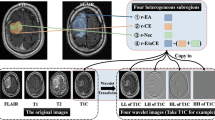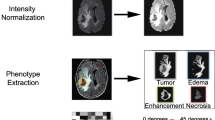Abstract
Purpose
To perform radiomics analysis for non-invasively predicting chromosome 1p/19q co-deletion in World Health Organization grade II and III (lower-grade) gliomas.
Methods
This retrospective study included 277 patients histopathologically diagnosed with lower-grade glioma. Clinical parameters were recorded for each patient. We performed a radiomics analysis by extracting 647 MRI-based features and applied the random forest algorithm to generate a radiomics signature for predicting 1p/19q co-deletion in the training cohort (n = 184). The clinical model consisted of pertinent clinical factors, and was built using a logistic regression algorithm. A combined model, incorporating both the radiomics signature and related clinical factors, was also constructed. The receiver operating characteristics curve was used to evaluate the predictive performance. We further validated the predictability of the three developed models using a time-independent validation cohort (n = 93).
Results
The radiomics signature was constructed as an independent predictor for differentiating 1p/19q co-deletion genotypes, which demonstrated superior performance on both the training and validation cohorts with areas under curve (AUCs) of 0.887 and 0.760, respectively. These results outperformed the clinical model (AUCs of 0.580 and 0.627 on training and validation cohorts). The AUCs of the combined model were 0.885 and 0.753 on training and validation cohorts, respectively, which indicated that clinical factors did not present additional improvement for the prediction.
Conclusion
Our study highlighted that an MRI-based radiomics signature can effectively identify the 1p/19q co-deletion in histopathologically diagnosed lower-grade gliomas, thereby offering the potential to facilitate non-invasive molecular subtype prediction of gliomas.



Similar content being viewed by others
References
Chen B, Liang T, Yang P et al (2016) Classifying lower grade glioma cases according to whole genome gene expression. Oncotarget 7(45):74031–74042
Louis DN, Perry A, Reifenberger G et al (2016) The 2016 World Health Organization classification of tumors of the central nervous system: a summary. Acta Neuropathol 131:803–820
Network CGAR (2015) Comprehensive, integrative genomic analysis of diffuse low-grade gliomas. N Engl J Med 372:2481–2498
Smith JS, Perry A, Borell TJ et al (2000) Alterations of chromosome arms 1p Fand 19q as predictors of survival in oligodendrogliomas, astrocytomas, and mixed oligoastrocytomas. J Clin Oncol 18:636–636
Lindberg N, Jiang Y, Xie Y et al (2013) Oncogenic signaling is dominant to cell of origin and dictates astrocytic or oligodendroglial tumor development from oligodendrocyte precursor cells. J Neurosci 33(42):16805–16817
Appin CL, Brat DJ (2014) Molecular genetics of gliomas. Cancer J 20(1):66
Bauman G, Ino Y, Ueki K et al (2000) Allelic loss of chromosome 1p and radiotherapy plus chemotherapy in patients with oligodendrogliomas. Int J Radiat Oncol Biol Phys 48:825–830
Ino Y, Betensky RA, Zlatescu MC et al (2001) Molecular subtypes of anaplastic oligodendroglioma. Clin Cancer Res 7:839–845
Kaloshi G, Benouaich-Amiel A, Diakite F et al (2007) Temozolomide for low-grade gliomas predictive impact of 1p/19q loss on response and outcome. Neurology 68:1831–1836
Reifenberger J, Reifenberger G, Liu L et al (1994) Molecular genetic analysis of oligodendroglial tumors shows preferential allelic deletions on 19q and 1p. Am J Pathol 145:1175–1190
Theeler BJ, Yung WA, Fuller GN et al (2012) Moving toward molecular classification of diffuse gliomas in adults. Neurology 79:1917–1926
Woehrer A, Hainfellner JA (2015) Molecular diagnostics: techniques and recommendations for 1p/19q assessment. CNS Oncol 4:295–306
Sanai N, Martino J, Berger MS (2012) Morbidity profile following aggressive resection of parietal lobe gliomas: clinical article. J Neurosurg 116:1182–1186
Tate MC, Kim C-Y, Chang EF et al (2011) Assessment of morbidity following resection of cingulate gyrus gliomas: clinical article. J Neurosurg 114:640–647
Ducray F, Idbaih A, Reyniès AD et al (2008) Anaplastic oligodendrogliomas with 1p19q codeletion have a proneural gene expression profile. Mol Cancer 7(1):41
Mukasa A, Ueki K, Ge X et al (2010) Selective expression of a subset of neuronal genes in oligodendroglioma with chromosome 1p loss. Brain Pathol 14(1):34–42
Van den Bent MJ, Smits M, Kros JM et al (2017) Diffuse infiltrating oligodendroglioma and astrocytoma. J Clin Oncol 35(21):JCO2017726737
Jenkinson MD, Du PD, Smith TS et al (2006) Histological growth patterns and genotype in oligodendroglial tumours: correlation with MRI features. Brain 129(Pt 7):1884
Megyesi JF, Kachur E, Lee DH et al (2004) Imaging correlates of molecular signatures in oligodendrogliomas. Clin Cancer Res 10:4303–4306
Patel SH, Poisson LM, Brat DJ et al (2017) T2-FLAIR mismatch, an imaging biomarker for IDH and 1p/19q status in lower grade gliomas: a TCGA/TCIA project. Clin Cancer Res. https://doi.org/10.1158/1078-0432.CCR-17-0560
Mpg B, Smits M, Mmj W et al (2018) The T2-FLAIR mismatch sign as an imaging marker for non-enhancing IDH-mutant, 1p/19q-intact lower grade glioma: a validation study. Neuro Oncol. https://doi.org/10.1093/neuonc/noy048
Lambin P, Rios-Velazquez E, Leijenaar R et al (2012) Radiomics: extracting more information from medical images using advanced feature analysis. Eur J Cancer 48:441–446
Kumar V, Gu Y, Basu S et al (2012) Radiomics: the process and the challenges. Magn Reson Imaging 30:1234–1248
Zhou M, Hall L, Goldgof D et al (2014) Radiologically defined ecological dynamics and clinical outcomes in glioblastoma multiforme: preliminary results. Transl Oncol 7:5–13
Zhou M, Scott J, Chaudhury B et al (2017) Radiomics in brain tumor: image assessment, quantitative feature descriptors, and machine-learning approaches. Am J Neuroradiol 39(12):208–216
Zhou M, Chaudhury B, Hall LO et al (2017) Identifying spatial imaging biomarkers of glioblastoma multiforme for survival group prediction. J Magn Reson Imaging 46(1):115–123
Aerts HJWL, Velazquez ER, Leijenaar RTH et al (2014) Decoding tumour phenotype by noninvasive imaging using a quantitative radiomics approach. Nat Commun 5:4006
Huang YQ, Liu ZY et al (2016) Radiomics signature: a potential biomarker for the prediction of disease-free survival in early-stage (I or II) non-small cell lung cancer. Radiology 281(3):947
Huang YQ, Liang CH, He L et al (2016) Development and validation of a radiomics nomogram for preoperative prediction of lymph node metastasis in colorectal cancer. J Clin Oncol 34:2157–2164
Henson JW, Gaviani P, Gonzalez RG (2005) MRI in treatment of adult gliomas. Lancet Oncol 6:167–175
Yushkevich PA, Piven J, Hazlett HC et al (2006) User-guided 3D active contour segmentation of anatomical structures: significantly improved efficiency and reliability. Neuroimage 31:1116–1128
Gebejes A, Huertas R (2013) Texture characterization based on grey-level co-occurrence matrix. Proc Conf Inf Manag Sci 2:375–378
Galloway MM (1975) Texture analysis using gray level run lengths. Comput Graph Image Process 4:172–179
Chu A, Sehgal CM, Greenleaf JF (1990) Use of gray value distribution of run lengths for texture analysis. Pattern Recognit Lett 11:415–419
Dasarathy BV, Holder EB (1991) Image characterizations based on joint gray level run length distributions. Pattern Recognit Lett 12:497–502
Thibault G, Fertil B, Navarro C et al (2013) Shape and texture indexes application to cell nuclei classification. Int J Pattern Recognit Artif Intell 27:1357002
Amadasun M, King R (1989) Textural features corresponding to textural properties. IEEE Trans Syst Man Cybern 19:1264–1274
Kim SH, Kim H, Kim TS (2005) Clinical, histological, and immunohistochemical features predicting 1p/19q loss of heterozygosity in oligodendroglial tumors. Acta Neuropathol 110:27–38
DeLong ER, DeLong DM, Clarke-Pearson DL (1988) Comparing the areas under two or more correlated receiver operating characteristic curves: a nonparametric approach. Biometrics 44:837–845
Louis BN, Jana P, Joachim B et al (2018) NCCN Guidelines Version 1.2018 Panel Members Central Nervous System Cancers. National Comprehensive Cancer Network
Buckner J, Giannini C, Eckelpassow J et al (2017) Management of diffuse low-grade gliomas in adults - use of molecular diagnostics. Nat Rev Neurol 13(6):340–351
Chahlavi A, Kanner A, Peereboom D et al (2003) Impact of chromosome 1p status in response of oligodendroglioma to temozolomide: preliminary results. J Neurooncol 61:267–273
Alattar AA, Brandel MG, Hirshman BR et al (2017) Oligodendroglioma resection: a surveillance, epidemiology, and end results (SEER) analysis. J Neurosurg 128:1076–1083
Yang XF et al (2012) Ultrasound GLCM texture analysis of radiation-induced parotid-gland injury in head-and-neck cancer radiotherapy: an in vivo study of late toxicity. Med Phys 39(9):5732
Brown R, Zlatescu M, Sijben A et al (2008) The use of magnetic resonance imaging to noninvasively detect genetic signatures in oligodendroglioma. Clin Cancer Res 14:2357–2362
Sanai N, Chang S, Berger MS (2011) Low-grade gliomas in adults: a review. J Neurosurg 115:1–18
Acknowledgements
This work was supported by the National Natural Science Foundation of China under Grant Numbers 81227901, 81527805, 81501616, and 81771924, the National Key Research and Development Program of China Grant under Grant Number 2106YFC0103702 and 2017YFA0205200. Olivier Gevaert is supported by the National Institute of Biomedical Imaging And Bioengineering of the National Institutes of Health under Award Number R01EB020527. The authors would like to express their deep appreciation to all anonymous reviewers for their kind comments.
Disclaimer
The content is solely the responsibility of the authors and does not necessarily represent the official views of the National Institutes of Health.
Author information
Authors and Affiliations
Corresponding authors
Ethics declarations
Conflict of interest
The authors declare that they have no conflicts of interest.
Electronic supplementary material
Below is the link to the electronic supplementary material.
Rights and permissions
About this article
Cite this article
Han, Y., Xie, Z., Zang, Y. et al. Non-invasive genotype prediction of chromosome 1p/19q co-deletion by development and validation of an MRI-based radiomics signature in lower-grade gliomas. J Neurooncol 140, 297–306 (2018). https://doi.org/10.1007/s11060-018-2953-y
Received:
Accepted:
Published:
Issue Date:
DOI: https://doi.org/10.1007/s11060-018-2953-y




